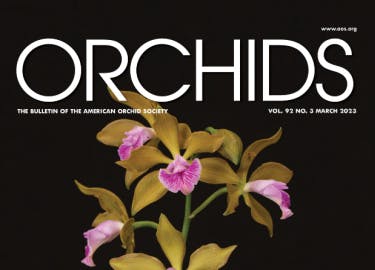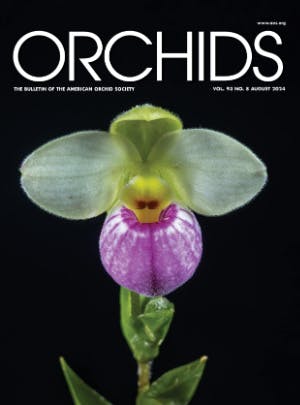
We all grow our orchids for the flowers, which we enjoy so much. Then again some species are worth growing just for the unusual growth habit of the plant.
The focus of this article is on members of the genus Dendrobium from the section Platycaulon; the latter term is derived from the Greek word “platus” for “flat” and the Latin word “caulis” meaning “stem.” The distinguishing characteristic of this section is the pseudobulbs, which are club-shaped and laterally flattened. The thinly textured leaves are arranged in two ranks on reduced and split sheaths along the stem. Another interesting botanical feature is that they have retained the swollen stem by stretching the sheaths rather than bunching the leaves distally. The pseudobulbs are initially erect, becoming pendulous with age. Older stems are leafless. The flowers are thought to be bee-pollinated and last about a week. In some species, the flowers open widely but in others, the blooms are cupped. There is uncertainty about the number of species as several of them are closely related, although up to about 12 species are generally recognized at present. Most experts consider section Platycaulon as being closely related to the larger section Calcarifera J.J. Smith. The geographic range of section Platycaulon is broad, from Myanmar (Burma), Thailand, the Philippines, Indonesia, New Guinea, Vanuatu and Fiji. The habitats are mostly lowland forests with year-round rainfall.
Rudolf Schlechter proposed this section in 1905 in Schumann and Lauterbach’s Nachträge zur Flora der Deutschen Schutzgebiete in der Südsee: mit Ausschluss Samoa’s und der Karolinen (Addendums on the Flora of the German Protected Areas in the South Seas: Excluding Samoa and the Caroline Islands). The type species for the section is Onychium lamellatum Blume, which when transferred to the genus Dendrobium became Dendrobium lamellatum (Blume) Lindley.
[1] Close-up an individual Dendrobium compressum flower. Grown by Jeff Champion.

A SELECTION OF SPECIES
Dendrobium compressum John Lindley named this species in 1842 in Edwards’s Botanical Register. The specific epithet refers to the flattened pseudobulbs. The plant can reach 5.0 inches (12.7 cm) in length. The flowers are golden yellow and about 0.75 inch (1.9 cm) in diameter. There is also a white- colored form. This is a widespread species, which has been recorded from Myanmar (Burma), Peninsular Malaysia, Sumatra, Java, the Natuna Islands and Borneo. It grows at elevations of between 400 and 4,000 feet (122–1,219 m).
Dendrobium davaoense Amihan Lubag-Arquiza named this plant in 2006 in the Australian Orchid Review. Plants reach a length of about 7 inches (17.8 cm). This recently described species has flowers about 0.75–1 inch (1.9–2.5 cm) in diameter. Flowers are variable in their coloration. The specific epithet refers to Davao City on the island of Mindanao in the southern Philippines. This species grows at elevations of about 4,400 feet (1,314 m) and is endemic to the Philippines.
Dendrobium lamellatum Carl Blume first named this species in 1825 as Onychium lamellatum. John Lindley transferred it to the genus Dendrobium in 1830 in his Genera and Species of Orchidaceous Plants. The specific epithet refers to the flattened pseudobulbs. Plants are about 5.0 inches (12.7 cm) in length. The flowers are about 0.75 inch (1.9 cm) in diameter. It has been recorded from Java, Sumatra and Thailand, where it grows from sea level up to about 4,000 feet (1,219 m).
[2] Dendrobium davaoense grown by Elmer C. Bagos.

Dendrobium milaniae Hans Fessel and Emil Lückel named this species in 1996 in the German publication Die Orchidee (“The Orchid”). The specific epithet honors Dr. Paciencia P. Milan of the Visayan State College of Agriculture on the island of Leyte, which is in the central Philippine archipelago. Plants are about 4.0 inches (10.2 cm) long × 0.75 inch (1.9 cm) wide × 1⁄8 inch (0.3 cm) thick. Flowers are variable in their coloration, and they are sweetly scented, reminiscent of violets. The species is endemic to the Philippines and only known from the southern Philippine islands, where it grows as an epiphyte at elevations of about 2,000 feet (610 m).
Dendrobium platycaulon Robert Rolfe described this plant in 1892 in the Kew Bulletin. The specific epithet (again) refers to the flattened pseudobulbs. Plants can reach a length of about 8 inches (20.3 cm). Inflorescences can carry up to five flowers, about 1 inch (2.5 cm) in diameter. This species is another Philippines endemic and only known from the northern islands of the Philippines, where it grows at elevations of about 2,000 feet (610 m).
Dendrobium platygastrium Heinrich G. Reichenbach named this plant in 1878 in Otia Botanica Hamburgensia (I can find no English translation for this publication). The specific epithet means “flat stomach.” I do not know to which feature of the flower this refers. The pseudobulbs of this plant can reach 18 inches (45.7 cm) in length, and the flowers are about 1.25 inches (3.2 cm) in diameter. Several inflorescences can be produced simultaneously. Dendrobium platygastrium is a widely spread species, which has been recorded from New Guinea, the Solomon Islands, Fiji and Vanuatu. It grows from sea level to about 6,000 feet (1,829 m).
Dendrobium pseudolamellatum Jeffrey Wood and Anthony Lamb described this species in 2010 in the Malesian Orchid Journal. The specific epithet means “false lamellatum” referring to the resemblance of this species to Den. lamellatum (Blume) Lindley. The plants are about 6.0 inches (15.2 cm) long and the leaves are extremely long, reaching over 8.0 inches (20.3 cm) in length by almost 3.0 inches (7.6 cm) in width. The underside of the leaves is deep purple. The inflorescences can have up to five flowers, but sometimes the inflorescences are underneath the leaves. This species is endemic to Borneo where it grows at elevations of between 1,000 and 2,400 feet (305–732 m).
Dendrobium speckmaieri Hans Fessel and Emil Lückel named this species in 2002 in the German publication Die Orchidee. The specific epithet honors Manfred Speckmaier, who found the plants used to make the description. This species only reaches 4.0 inches (10.2 cm) in length and just over 1⁄2 inch (1.3 cm) in width; the flowers are about 1 inch (2.5 cm) in diameter. It is endemic to northern Sulawesi, where it grows at elevations of about 5,000 feet (1,524 m).
Dendrobium treubii Johannes J. Smith named this orchid in 1906 in Orchids of Ambon. The specific epithet honors a Professor Treub. The pseudobulbs of this plant can reach 18 inches in length, and the flowers are about 2.25 inches (5.7 cm) in diameter. This species is only known from the islands of Ambon and Ceram in the Indonesian archipelago and grows at low elevations.
[3] Dendrobium lamellatum

CuLTIVATION
In cultivation, warm-to-intermediate conditions with year-round moisture and filtered sunlight are recommended.
[4] Dendrobium milaniae photographed in situ.

Acknowledgment
My sincere thanks to Elmer Bagos (Philippines), Ronny Boos (Philippines), Jeffrey Champion (Bali, Indonesia) and Ron Parsons (uSA) for the use of their pictures to help illustrate this article.
[5] Dendrobium milaniae clearly showing the unusual growth habit of this section.

[6] An orange form of Dendrobium milaniae.

[7] Dendrobium platycaulon photographed in situ.

[8] Dendrobium platycaulon

Further Reading
Cootes, J. 2011. Philippine Native Orchid Species. Katha Publishing, Quezon City, Philippines.
Lavarack, B., W. Harris and G. Stocker. 2000. Dendrobium and its Relatives. Kangaroo Press, Kenthurst, New South Wales, Australia.
Lewis, B. and P.J. Cribb. 1989. Orchids of Vanuatu. Royal Botanic Gardens, Kew, Richmond, united Kingdom. Wood, H.P. 2006. The Dendrobiums. A.R.G. Gantner
Verlag, Ruggell, Liechtenstein.
Wood, J.J. 2014. Dendrobium of Borneo. Natural History
Publications (Borneo), in association with Royal Botanic
Gardens, Kew, Richmond, united Kingdom.
[9] Dendrobium pseudolamellatum grown by White Oak Orchids.

[10] Dendrobium platygastrium

[11] Dendrobium treubii grown by Cindy Hill.

[12] Dendrobium speckmaieri grown by Marni Turkel.

— Jim Cootes has grown orchids for almost 50 years. He specializes in species orchids of Australia and Asia, particularly those of the Philippines. Mr. Cootes has written three books on Philippines orchid species and has also written countless articles, both scientific and of a more general nature that have been published worldwide. He lives in Sydney, Australia, where he keeps a small collection of orchids (email: jimcootes@gmail.com).












